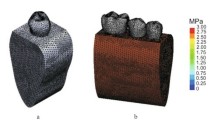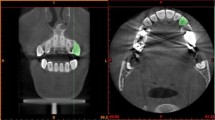Abstract
The aim of this study was to compare the areas of stress concentration in a three-dimensional (3D) premolar tooth model with anisotropic or isotropic enamel using the finite element method. A computed tomography was imported to an image processing program to create the tooth model which was exported to a 3D modeling program. The mechanical properties and loading conditions were prescribed in Abaqus. In order to evaluate stresses, axial and oblique loads were applied simulating realistic conditions. Compression stress was observed on the side of load application, and tensile stress was observed on the opposite side. Tensile stress was concentrated mainly in the cervical region and in the alveolar insertion bone. Although stress concentration analyses of the isotropic 3D models produced similar stress distribution results when compared to the anisotropic models, tensile stress values shown by anisotropic models were smaller than the isotropic models. Oblique loads resulted in higher values of tensile stresses, which concentrate mainly in the cervical area of the tooth and in the alveolar bone insertion. Anisotropic properties must be utilized in enamel stress evaluation in non-carious cervical lesions.





Similar content being viewed by others
References
Bajaj D, Arola D (2009) Role of prism decussation on fatigue crack growth and fracture of human enamel. Acta Biomater 5:3045–3056
Benzing UR, Gall H, Weber H (1995) Biomechanical aspects of two-implant-prosthetic concepts for edentulous maxillae. Int J Oral Maxilofac Implants 2:188–198
Borcic J, Anic I, Smojver I, Catic A, Miletic I, Ribaric SP (2005) 3D finite element model and cervical lesion formation in normal occlusion and in malocclusion. J Oral Rehabil 32:504–510
Dejak B, Mlotkowski A, Romanowicz M (2005) Finite element analysis of mechanism of cervical lesion formation in simulated molars during mastication and parafunction. J Prost Dent 94:520–529
Fernandes CP, Chevitarese O (1991) The orientation and direction of rods in dental enamel. J Prost Dent 65:793–800
Ferrario VF, Sforza C, Serrao G, Dellavia C, Tartaglia GM (2004) Single tooth bite in young adults. J Oral Rehabil 31:18–22
Frost HM (2003) Bone’s mechanostat: a 2003 update. Anat Rec A Discov Mol Cell Evol Biol 275:1081–1101
Gao J, Xua W, Dingb Z (2006) 3D finite element mesh generation of complicated tooth model based on CT slices. Comput Methods Progr Biomed 82:97–105
Giannini M, Soares CJ, Carvalho RM (2004) Ultimate tensile strength of tooth structures. Dent Mater 20:322–329
Gibbs CH, Mahan PE, Lundeen HC, Brehnan K, Walsh EK, Holbrook WB (1981) Occlusal forces during chewing and swallowing as measured by sound transmission. J Prost Dent 46:443–449
Grippo J (1991) Abfractions: a new classification of hard tissue lesions of teeth. J Esthet Dent 3:14–19
Ichim I, Lib Q, Loughranc J, Swaina MV, Kiesere J (2007) Restoration of non-carious cervical lesions Part I. Modelling of restorative fracture. Dent Mater 23:1553–1561
Las Casas EB, Cornacchia TP, Gouvêa PH, Cimini JRCA (2003) Abfraction and anisotropy effects of prism orientation on stress distribution. Comput Methods Biomech Biomed Eng 6:65–73
Lee WC, Eakle WS (1984) Possible role of tensile stress in the etiology of cervical erosive lesions of teeth. J Prost Dent 52:374–380
Lee HE, Lin CL, Wang CH, Cheng CH, Chang CH (2002) Stresses at the cervical lesion of maxillary premolar—a finite element investigation. J Dent 30:283–290
Litonjua LA, Bush PJ, Andreana S, Tobias TS (2004) Effects of occlusal load on cervical lesions. J Oral Rehabil 31:225–232
Lynch CD, O’Sullivan VR, Dockery P, McGillycuddy CT, Sloan AJ (2010) Hunter–Schreger band patterns in human tooth enamel. J Anat 217:106–115
Miura J, Maeda Y, Nakai H, Zako M (2009) Multiscale analysis of stress distribution in teeth under applied forces. Dent Mater 25:67–73
Okeson J (2008) Treatment of temporomandibular disorders and occlusion in: determinants of occlusal morphology, 6th edn. Elsevier, Rio de Janeiro, pp 89–102
Palamara D, Palamara JEA, Tyas MJ, Messer HH (2000) Strain patterns in cervical enamel of teeth subjected to occlusal loading. Dent Mater 16:412–419
Rees J (2002) The effect of variation in occlusal loading on the development of abfraction lesions: a finite element study. J Oral Rehabil 29:188–193
Rees JS, Jacobsen PH (1997) Elastic modulus of the periodontal ligament. Biomaterials 18:995–999
Robinson C, Kirkham J, Brookes SJ, Bonass WA, Shore RC (1995) The chemistry of enamel development. Int J Dev Biol 39:145–152
Roy S, Basu B (2008) Mechanical and tribological characterization of human tooth. Mater Character 52:747–756
Sano H, Ciucchi B, Matthews MG, Pashley DH (1994) Tensile properties of mineralized and demineralized human and bovine dentin. J Dent Res 73:1205–1211
Spears IR (1997) A three-dimensional finite element model of prismatic enamel: a re-appraisal of the data on the Young’s modulus of enamel. J Dent Res 76:1690–1697
Spears IR, Noort RV, Crompton GE, Cardew Howard IC (1993) The effects of enamel anisotropy on the distribution of stress in a tooth. J Dent Res 72:1526–1531
Tanaka M, Naito T, Yokota M, Kohno M (2003) Finite element analysis of the possible mechanism of cervical lesion formation by occlusal force. J Oral Rehabil 30:60–67
White SN, Luo W, Paine ML, Fong H, Sarikaya M, Snead ML (2001) Biological organization of hydroxyapatite crystallites into a fibrous continuum toughens and controls anisotropy in human enamel biological. J Dent Res 80:321–326
Wood I, Jawad Z, Paisley C, Brunton P (2008) Non-carious cervical tooth surface loss: a literature review. J Dent 36:759–766
Acknowledgments
The student received scholarship from the Conselho Nacional de Desenvolvimento Científico e Tecnológico (CNPq#132229/2011-0). We thank the Pró-reitoria de Pesquisa da UFMG for the English review.
Conflict of interest
The authors declare that there is no conflict of interest.
Author information
Authors and Affiliations
Corresponding author
Rights and permissions
About this article
Cite this article
Munari, L.S., Cornacchia, T.P.M., Moreira, A.N. et al. Stress distribution in a premolar 3D model with anisotropic and isotropic enamel. Med Biol Eng Comput 53, 751–758 (2015). https://doi.org/10.1007/s11517-015-1289-4
Received:
Accepted:
Published:
Issue Date:
DOI: https://doi.org/10.1007/s11517-015-1289-4




